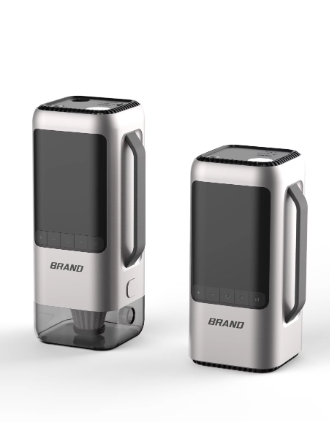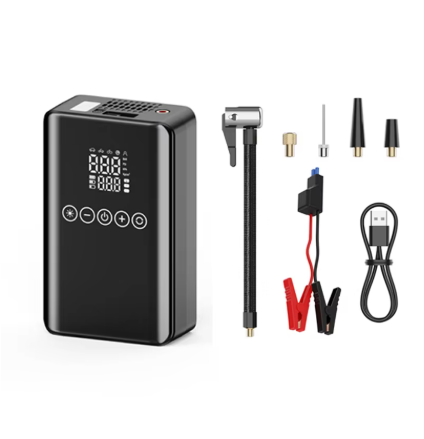Дугуйн агаар дутмаг болохоос сэргийлэхийн тулд өвөрт машин дугуй агааржуулагчийг ашиглаж болох уу?
Яагаад өвөл шинэ даралтаа алддаг вэ
Багассан налдамж: Даралт багасах нь замын гадаргуутай шиний хүрэх талбайн хэмжээг нэмэгдүүлдэг ч, тэгш бус хуваарилалт нь цас, мөсөн дээр муу налдамжтай болох ба гулсах эрсдэлийг нэмэгдүүлдэг.
Хэт бага агаарын даралттай бол замын дугуй хүрээний идэлт тэнцвэргүй болох ба ялангуяа эрүүний хэсгийн идэлт ихсэж, амьдралын хугацааг богиносгоно.
Шатахууны зарцуулалт нэмэгдэнэ: Хэт бага агаарын даралттай замын дугуйн хөдөлгөөний эсэргүүцэл ихсэж инженерийн ачаалал нэмэгдэх бөгөөд шатахууны зарцуулалтыг хүртэл 3%-иар бууруулна.
Аюултай хэмжээний даралтгүй болох тухай , маш бага даралттай замын дугуй жолоодоход хэт халж, цаашид тасрах магадлалыг нэмэгдүүлнэ — онцон сэрүүн улиралд энэ нь илүү аюултай байдаг.

Хүйтэн уур амьсгалд замын дугуйд агаар оруулах төхөөрөмж хэрхэн ажилладаг вэ
Баттерейн найдвартай ажиллагаа: Литиум-ион баттерейтэй утасгүй автомашины агааржуулагч нь хүйтэн цаг агаарт ажиллаж чадна. Гэсэн хэдий ч баттерейн багтаамж нь сөрөг температур дахин 10–20%-иар буурч болно. Ашиглахгүй үед агааржуулагчийг машин дотор шигүү газар хадгалах нь баттерейн ажиллагааг сайн байлгахад тусална.
Даралтын нарийвчлал: LCD дэлгэцийн болон урьдчилан тогтоосон даралтын тохиргоотой цифров агааржуулагч нь аналог загваруудаас илүү найдвартай ажилладаг. Жолоочид машины үйлдвэрлэгчийн зөвлөсөн psi-г нарийвчлан тохируулах боломжийг олгодог тул хэтрүүлэн дүүргэлгүйгээр нарийвчлалтай агааржуулна.
Эрч хүчтэй бүтэц: Өвөлд зориулсан автомашины агаар шахагуур нь ихэвчлэн хоолой, вентиль хоёр дахин хөлдөөг тэсвэрлэдэг материалыг ашигладаг бөгөөд хөлдөөн дээр треск үүсэхээс сэргийлдэг. Зарим загварууд нь мөн гэрлийн диодт гэрэл агуулдаг бөгөөд өвөлд оройн цагт дугуйгаа агааржуулахад тохиромжтой.
Автомобилийн агаар шахагуурыг өвөлд ашиглах шилдэг аргачлал
Даралтыг үргэлж шалгаарай: Өвдөг дээр температур хэлбэлзэх тул амьсгалын даралтыг дор хаяж долоонд нэг удаа шалгаарай - боломжтой бол хөдөлгүүрийг асаахаас өмнө (үрэлт нь даралтыг түр зуур ихэсгэдэг). Хэрэгтэй бол машин цохилтуурыг ашиглаад машины хаалганы эрмэг буюу өмчлөгчийн гарын авлагад заасан psi-ийг ашиглаарай.
Цохилтуурыг дулаацуулах (шаардлагатай бол): Маш хүйтэн нөхцөлд (-15°C-аас доош), утасгүй цахилгаан цохилтуурын баттерей муудаж болно. Ашиглахаас өмнө гараараа дулаацуулах эсвэл 5-10 минутын турш цамцны дотор тавих нь ажиллагааг сайжруулна.
Вентиль ба хоолойг шалгаарай: Хүйтэн цаг агаар нь вентилийн хоолойг хугалах магадлалтай. Цохилтуур ашиглахаас өмнө вентиль цэвэр, гэмгүй байгаа эсэхийг шалгаарай. Ширэм, мөсний дараа вентиль дээр цөөн хэмжээний силикон тос түрхэх нь хөлдөөгүй байлгахад тусална.
Хэтэрхий агааржуулалтаас сэргийл: Хүйтэн агаар халахдаа тэлдэг тул мөсөн орчинд дугуйг максимум psi-р агааржуулах нь температур ихсэхэд даралт ихсэж болзошгүй. Тиймээс жилийн цагаас үл хамааран үйлдвэрлэгчийн зөвлөсөн даралтыг баримтла.
Зохих байдлаар хадгала: Машины агааржуулагчийг хатуу, температур тогтвортой газар (багцын хаалга биш, учир нь энэ нь маш хүйтэн байж болно) баттерей ба бүрэлдэхүүн хэсгүүдийг хамгаалахын тулд хадгална уу. Аварга тохиолдолд нөөц предохранитель болон вентиль адаптеруудыг хадгалалтын хайрцагт оруулж аваарай.
Машины агааржуулагчийг професионал үйлчилгээнд хэр когаа ашиглах вэ?
Давтан зүрхэлдэг шүүдэл: Хэрэв дугуй агаарыг дахин дахин алдаж байвал (7 хоногт 2–3 psi-аас илүү), түүнд хурц зүйл хатгаж эсвэл вентиль эвдэрсэн байж болно. Машин дүүргэгч нь түр агаарын даралтыг сэргээж болох ч дугуйг мэргэжилтэн шалгаж, засах хэрэгтэй.
Хөлдсөн вентиль эсвэл дугуй: Хүчтэй хөрөн дээр вентиль хөлдөж хаагдах ба агаар оруулах боломжгүй болно. Вентиль дээр хөлдүү буруулах шүршиг уусгах уусмал түлхэх аргад зохино, гэвч дугуй газартайгаа хөлдсөн тохиолдолд дугуйг эвдэрээс хамгаалахын тулд мэргэжилтэнд тусламж хүсэх шаардлагатай байж болно.
Хэтэрхий хоригдол: Зүсэлт, хөвөнгөр, талын ханын гэмтэл нь тул даруй солих шаардлагатай. Машин дүүргэгч нь бүтцийн асуудлыг засах чадвартай биш ба ийм дугуйгаар жолоо ашиглах нь аюултай юм.
Түгээмэл асуулт: Өвлийн улиралд машин дүүргэгч
Машин дүүргэгчийг хөлдөөс доош температурт ашиглах боломжтой юу?
Өвөл дугуйгаа агааржуулагч машины хэдэн минутын дотор дүүргэх вэ?
Өвөл дугуйгаа агааржуулагч машины цахилгааны аккумуляторыг цэнэгээс хоослох уу?
Дугуйгаа агааржуулагчийг цасаар бүрхэгдсэн дугуй дээр ашиглах боломжтой юу?
Өвлийн улиралд онц specifically designed for winter use?
Гарчиг
- Дугуйн агаар дутмаг болохоос сэргийлэхийн тулд өвөрт машин дугуй агааржуулагчийг ашиглаж болох уу?
- Яагаад өвөл шинэ даралтаа алддаг вэ
- Хүйтэн уур амьсгалд замын дугуйд агаар оруулах төхөөрөмж хэрхэн ажилладаг вэ
-
Түгээмэл асуулт: Өвлийн улиралд машин дүүргэгч
- Машин дүүргэгчийг хөлдөөс доош температурт ашиглах боломжтой юу?
- Өвөл дугуйгаа агааржуулагч машины хэдэн минутын дотор дүүргэх вэ?
- Өвөл дугуйгаа агааржуулагч машины цахилгааны аккумуляторыг цэнэгээс хоослох уу?
- Дугуйгаа агааржуулагчийг цасаар бүрхэгдсэн дугуй дээр ашиглах боломжтой юу?
- Өвлийн улиралд онц specifically designed for winter use?

